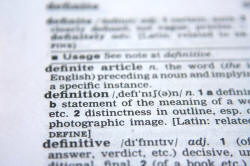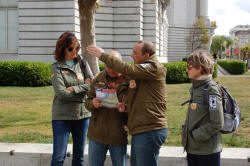The infinitive in English

The title of this guide deliberately refers to in English.
Some languages, such as Modern Greek, Japanese and a range of other
languages have nothing that is recognisably an infinitive and in
other languages, the base form of a verb plays no grammatical role.
It is unsurprising that learners of English, especially from those
language backgrounds, have some difficulty understanding the concept
of an infinitive and using it successfully.
In many other languages, including many European ones, a single form
of the verb does service as the equivalent of the English bare
infinitive, the infinitive with to and the -ing
form of a verb.
 |
Definition |
In the initial plus section of this site, there is an essential guide to the infinitive which explains what the infinitive is and how it is used. The assumption here is that you already understand the distinction between bare and to-infinitives and between finite and non-finite verb forms but a rapid reminder may be helpful:
The infinitive in English is known as non-finite. That
means that you can't tell by looking at it whether it refers to me,
you, lots of people, the past, the present or the future.
Compare, for example, the verbs in
He wants to
make a cake.
The verb wants has an -s ending here and that tells us that
it refers to a singular person, it refers to the third person (it
can't refer to me or you) and it is present tense. If we
change the form of this verb, we change its function:
He wanted to make a cake
They want to make a cake
etc.
The verb make does not tell us any of these things.
It will not change if I replace he with you or
wants with wanted or want.
The word infinitive, incidentally derives from the Latin meaning, roughly, unlimited and that is the clue to its nature – the infinitive is not limited by person, tense or number. It just is.
This guide covers the main ways in which the infinitive is used in English (whether bare or with to).
 |
Infinitives and modal auxiliary verbs |
| You can go now |
This is probably the most common use of the infinitive in English
and the first use that most learners encounter. This is not
the place to consider all the possible meanings and uses of the
infinitive with modal auxiliary verbs but it is worth noting that
one usual distinction between pure and semi-modal auxiliary verbs is to
consider whether or not they are followed by the bare or the to-infinitive.
Like this:
| Pure or central modal auxiliary verbs | Infinitive form |
| can | could | may | might | shall | should | will |would | must | ought to | Followed by the bare infinitive, e.g., go |
| Semi-modal auxiliary verbs | Followed by the to infinitive, e.g., to go |
| used | need | dare | |
| Marginal modal auxiliary verbs | |
| happen | care | mean | seem | tend | turn out | be about | be likely | be supposed |
It is fairly easy to spot the rogue here. It is the verb
ought which, because it is followed by the to-infinitive,
is often classified as a semi-modal auxiliary verb. That is not the view
taken on this site because in most other respects the verb is a
central or pure
modal auxiliary verb, having no truly lexical form in the way that semi-modal
auxiliary verbs do.
There is more on all of this linked in the list of related guides at the end
(follow the link to the modality index).
What is less easy to notice from the list above is the colligational nature of some of the verbs.
We can, for example, have both:
They can do the work
and
The work can be done
so both active and passive uses of the infinitive are acceptable.
The same applies to all the other pure or central modal auxiliary
verbs listed above.
When we look at the semi-modal auxiliary verbs, the following are
acceptable:
They used to do the work
The work used to be done
They needed to do the work
The work needed to be done
but with the semi-modal auxiliary verb dare, the passive use of the
infinitive is not acceptable:
They dared tell the teacher
*The teacher was dared to be told.
With the marginal modal auxiliary verbs listed, the situation is more diverse and less clear cut:
- happen, mean and care cannot be used in
the passive so:
*He happened to be talked to
*The work meant to be done
*The restaurant cared to be visited
are not acceptable. - The remaining marginal modal auxiliary verbs can be used with a
passive infinitive so, for example:
The work seemed to be finished
The work tended to be done
The work turned out to be done
The work was about to be done
The work was likely to be done
The work was supposed to be done
are all acceptable.
 |
Tense, aspect and voice with the infinitive |
The infinitive has just two tense forms:
- The present infinitive:
I am happy to help - The perfect infinitive
I am happy to have helped
Both of these can take on aspectual meanings with progressive forms:
- The present progressive infinitive:
I am happy to be helping - The past progressive infinitive:
I am happy to have been helping
These forms are subject to the same constraints and structural rules as the simpler form of the infinitive.
The guide to the passive, linked below, considers passive infinitives in some depth. Here it will be enough to exemplify the two main forms:
- Present passive infinitive:
I want to be invited - Perfect passive infinitive:
It should have been repaired
Both of these forms can be combined with the progressive aspect
to make complex formulations such as:
It needs to be being continuously oiled
The machine should have been being serviced more often
but such forms are rare and of varying acceptability to some
speakers.
 |
Catenative verbs |
| Let go! |
The verb catenate may be defined as join together in a
series and, just like modal auxiliary verbs, there is a range of
verbs in English which can be followed by a non-finite form.
That form may be the bare infinitive, the to-infinitive or
the -ing form. We are
only concerned with the first two of these here.
Strictly speaking, catenative verbs are those in which the main verb
is followed directly by the non-finite form with no intervening
object so, for example
I intend to go
I like swimming
are true catenative structures but
I want him to go
She watched them playing
are not.
For the purposes of this guide we will ignore this technicality but
the guide to catenative verbs linked in the list of related guides at the end, does not.
- Verbs which are followed
directly by a bare infinitive are almost a closed set and
the uses are quite rare. The passive is almost impossible
with any of these. They include:
- let, as in, e.g.:
Don't let go! - make, as in e.g.:
She made do with very little furniture - help, as in, e.g.:
Please help repair the table - hear, as in e.g.:
I hear tell he's quite rich
- let, as in, e.g.:
- Verbs which are followed by an object plus the bare
infinitive are of two main sorts:
- verbs of physical (not mental†) perception. These verbs refer to a single
event rather than anything progressive or iterative and can
often be
used in the passive. They include:
- I felt the ground move
- She heard the door open
- I noticed the car swerve
- They observed man break in
- I perceived the rain start
- I saw the man arrive
- I smelt the dinner burn
- I watched the man jump
(When these verbs are followed by an -ing form they imply that the whole of an event was not perceived. So for example:
They observed the man breaking in
implies that the action began before the observation and may have continued after it.
Compare, too:
I saw her sing at the opera vs. I saw her singing in the garden
I smelt the dinner burn vs. I smelt the dinner burning
and so on.
For other examples, see the guide to finite and non-finite forms, linked below.)
- Other verbs, with the same structural characteristics including:
- The teacher had me do it again
- I helped her get up
- I let her go early
- I have known it be cold in April
- I made them stay late
- verbs of physical (not mental†) perception. These verbs refer to a single
event rather than anything progressive or iterative and can
often be
used in the passive. They include:
- Verbs which are directly followed by the to-infinitive
form a large group and many of them refer to the future rather
than the past. (When reference is to the past or to a view based on past experience, the -ing
form is usually the form which follows.)
- These verbs include:
afford, agree, aim, apply, arrange, attempt, care, chance, choose, condescend, consent, contrive, decide, decline, demand, deserve, determine, endeavour, expect, fail, happen, hasten, hesitate, hope, intend, learn, long, manage, mean, offer, prepare, pretend, proceed, profess, promise, refuse, resolve, seek, seem, strive, struggle, swear, threaten, trouble, undertake, volunteer, wait, want, wish. - In nearly all cases, the verbs refer to a prospective rather than past action (but there are a few exceptions).
- None can be used with an intervening object, even when
they are transitive so we allow, for example:
He failed / struggled / swore / promised / wanted to pass the examination
but not:
*He failed / struggled / swore / promised / wanted the examination to pass. - Passive uses are vanishingly rare or forbidden because no intervening object is present.
- These verbs include:
- Verbs which are followed by an object and the to-infinitive
are rarer but can by their nature be used in the passive
include:
advise, allow, ask, beg, compel, encourage, forbid, force, get (=persuade), help, instruct, intend, invite, oblige, order, permit, persuade, press, recommend, request, remind, show (how), teach, tell, tempt, urge, warn (not)
So, for example, we can have:
Two of these verbs resist passive constructions so we do not usually encounter:Active form → Passive form I advised her to wait → She was advised to wait They compelled me to answer → I was compelled to answer She invited the vicar to come → The vicar was invited to come The man reminded me to attend → I was reminded to attend and so on
The woman was got to answer
The man was intended to help
† When the verb refers to metaphorical mental perception
rather than physical perception, a that-clause is
preferred. For example:
Physical perception:
I heard the bell ring
Mental perception
I heard that the bell is broken
not
*I heard the bell break
because that carries a different meaning of hear.
Physical perception:
I felt the rain start
Mental perception:
I felt that the rain will help the garden
not
*I felt the rain help the garden
For fuller lists, see the guide to catenative verbs linked in the list of related guides at the end.
 |
The infinitive as the subject or object |
| To miss the fireworks would be crazy |
With catenative verbs the infinitive forms part of the object of the main verb but infinitives can also be nominalised to form the subject of a verb or be part of a nominalised non-finite clause. The form is almost always marked in some way for emphasis and is much more frequent in spoken rather than written language. For example:
- To argue with her is pointless
which is the marked form of
It is pointless to argue with her - To see the ballet was a delight
which is the marked form of
It was a delight to see the ballet - To be a member is a real privilege
which is the marked form of
It is a privilege to be a member
Occasionally, a for-phrase may be inserted before the infinitive as in, for example:
- For her to be so rude was surprising
which is the marked form of
I was surprised that she was so rude - For the car to break down at that time was very
inconvenient
which is the marked form of
It was very inconvenient for the car to break down at that time - For me to do it would be impossible
which is the marked form of
It would be impossible for me to do it
Infinitive clauses can also post modify the subject noun and form part of a nominalised clause as the subject of the verb. For example:
- The right man to ask is John
which is the marked form of
John is the right man to ask - The next train to arrive at Platform 6 is the 15:40 for
Victoria
which is a marked form commonly used in announcements because it fronts information relevant to those standing on Platform 6 and alerts them to the importance of the information for them.
It would be more difficult for passengers to understand:
The 15:40 for Victoria is the next train to arrive at Platform 6 - The best place to stay is the Grand Hotel
which is the marked form of
The Grand Hotel is the best place to stay.
Nominalised infinitive constructions can also operate as the
object of verbs, of course, and any transitive verb followed by the
infinitive can be analysed as the verb plus a nominalised infinitive
clause object as in, e.g.:
I expected to go
I chose to have the argument
I want to see her
and that is not at all unusual.
All the uses of the infinitive with transitive verbs can be replaced
by simple noun phrases so we can also have:
I expected the bus
I chose the silver car
I want the money
It is worth commenting in passing that the -ing form is
often referred to as a gerund (or, a somewhat different concept, a verbal noun) in expressions such
as:
I enjoy swimming
I remember going to the game with her
etc.
If these forms are nouns (i.e., gerunds) then it makes sense, too,
to refer to infinitive clauses as nouns in these circumstances.
 |
The infinitive after adjectives |
|
I was astonished to see the
boat and it was hard to see how it got there |
There are two main sorts of adjectives which are followed by an
infinitive, and it is always the to-infinitive which is used.
Simply telling learners that the bare infinitive does not follow an
adjective may avoid a good deal of error.
The following are unmarked forms of some of the structures seen in
the previous section. Most of the clauses can be rephrased for
marked meaning, i.e., emphasis, so we could have, for example:
To see the difference is important
instead of the more normal, i.e., unmarked:
It is important to see the difference
- Used with the dummy or anticipatory it:
Many of these are modal adjectives, some epistemic (referring to possibility or likelihood) some deontic (referring to obligation) and some dynamic (referring to ability).- The form is
It + be + adjective + to-infinitive + object or other verb complement
as in, for example:
It is important to see the difference
It is impossible to believe he can do it - epistemic adjectives include:
impossible, common, unusual, rare, possible, certain, likely, unlikely, normal. For example:
It is impossible to believe it
It is certain to be her
It is unusual to accept it - deontic adjectives include:
wrong, right, crazy, important, necessary, good, bad, essential, unnecessary. For example:
It is wrong to accept the money
It is crazy to believe her
It is essential to change the oil - dynamic adjectives (referring to ability) include:
easy, difficult, hard, simple. For example:
It is easy to believe her
It is difficult to accept that
It is hard to do it
- The form is
- Used to describe someone's feelings:
- The form is
Subject + copular verb + adjective + to-infinitive + object or other verb complement
as in, for example:
She is happy to come to the party
They are reluctant to eat it
They seem delighted to be here - Many common adjectives work in this way and many
represent some form of dynamic modality, in this case that
of willingness. They
include:
glad, surprised, happy, pleased, delighted, sorry, willing, concerned, disappointed, mortified, astonished, unhappy, anxious and more. For example:
I am glad to help
She would be delighted to assist
The were disappointed not to see her
- The form is
Both types of structure exemplified here can be used in the passive although not all adjectives naturally so. For example:
- They were delighted to have been asked
- I was disappointed not to have been promoted
- It is unusual to be invited to the palace
In particular, the adjectives frequently used with the anticipatory it are rare in the passive and often sound clumsy or plain wrong. We would not normally accept, for example:
- ?It was certain to be done
- *It is important to be finished
- *It is difficult to be accomplished
Passive infinitives are considered in much more detail in the guide to the passive. You can open that section of the guide in a new tab by clicking here.
 |
The infinitive of reason or purpose |
| She wrote to ask how he was |
This is not an uncontroversial category because the sense of
reason or purpose is often contained within the verb itself, and it
may be argued that the use of to in these structures is
better considered prepositional rather than part of the to-infinitive
(hence its possible replacement with the complex preposition in order to).
However, for teaching purposes, the category is sometimes useful as,
superficially at least, the structure is similar to the forms
already considered.
Here, a few examples will do:
- I came to find out what was happening
- She went to London to see her mother
- I came to help with the cooking
etc.
There are some complications:
- Negating the structures is more complicated because a
sentence such as
I sat in the shade not to get sunburnt
is clumsy and usually replaced with
I sat in the shade so as not to get sunburnt
or
I sat in the shade in order not to get sunburnt - The verbs go and come are routinely
followed by and rather than to, especially
informally, so, we prefer
Go and look
to
Go to look
and
Come and see
to
Come to see - Slightly less acceptably to many people, and something
deprecated in formal English, is the use of and with
the verb try as in, for example:
Try and help her
rather than the more formally correct
Try to help her - The verb wait is frequently used with and
rather than to as in, for example:
Let's just wait and see
but in this case, it is arguable that the meaning is different from
Let's just wait to see
because the former implies two actions following each other and the latter implies the reason for waiting.
Error alert:
The verbs come, get, grow, begin and start are
often followed by a to infinitive but do not imply causality; they
imply a sense of a gradual process. So for example:
I came to like her
does not allow an alternative with in order to and nor do:
I got to know her
I grew to enjoy the weather
We began to lose touch
We started to meet quite often
 |
The infinitive after be: prohibitions, orders and absolute arrangements |
| You are not to eat the apple |
A form that is almost unique to English (among European
languages, at least) is the use of the infinitive after the verb
be to signal absolute obligations and prohibitions.
The structure is formal and often used in notices and other written texts
produced by those in authority.
Examples of the use are:
Children are not to leave the premises unaccompanied
Passengers are not to proceed beyond this point
Officers are to be in uniform at all time
Desks are to be kept tidy
This door is to be kept clear of obstructions
An allied construction concerns the future, whether in the past
and unfulfilled or prospective in sense. The meaning is akin
to the previous examples because the expression carries an
implication of inevitability unusual for future forms in English.
Examples include:
There is to be another meeting tomorrow.
There was to be a rehearsal that afternoon but the director
was ill
We are to meet again tomorrow
We were to see the boss the next day
and so on.
 |
The infinitive after too and enough |
| It was too cold to play |
Both these adverbs are routinely followed by the to-infinitive
(and never by the bare infinitive). They are often analysed as
a subset of the previous category but that is mistaken because here
it is rarely possible to use the complex subordinator in order
to as an alternative.
Again some examples are enough because the structure is quite
simple:
- The food was too hot to eat
- We don't have enough money to take a holiday
- She was sensitive enough not to ask the question
- I was simply too tired to do it
With this structure, negation is more straightforward. For example:
- The food wasn't too spicy to eat
- It wasn't too wet to go for a walk
- There weren't enough people to do the work
- I wasn't alert enough to spot the problem
There are some complications:
- The infinitive can follow an
adjective or a noun phrase and that is something not parallelled in
many languages. For example:
The food was good enough to eat
or
We took enough food to keep us going for the whole day - Only the adverb enough can be used preceding a noun
phrase so we allow:
She had enough books to read
but we do not allow
*She had too books to read - The adverb enough follows the adjective but
precedes the noun (when it is a determiner, not an adverb) so we get, for example:
The weather was nice enough to go for a walk
The was enough rain to help the garden - There is a formal use of enough following the noun
phrase (again as a determiner) rather than preceding it as in, e.g.:
There was rain enough to help the garden
She had books enough to read - The adverb too only precedes an adjective.
For example:
The pie was too hot to eat
not
*The pie was hot too to eat
 |
The infinitive after wh-words and impersonal pronouns |
| He told us where to go and how to get there |
All wh-words, apart from why, are frequently followed by the to-infinitive. For example:
- I don't know how to ask
- He explained what to do
- He told me when to begin
- She showed him where to get the bus
- I wanted to know who to ask
- I knew which to use
- She told me whose to take
Of these, the first four, using how, what, when and
where are the most frequent. The words which and
whose are less commonly used this way.
Although permitted in many languages, the word why may not,
in English be followed by the infinitive with to. We
do not see, therefore:
*She asked him why to do it
but that is allowed in many languages and is the source of some
interlingual error.
The indefinite or impersonal pronouns -thing, -one and -body series with some-, any-, no- and every- are also frequently followed by the to-infinitive. For example:
- I don't have anything to say
- He has something to explain
- We have everything to play for
- She needs something to wear
- They had nothing to open it with
- There was nobody to talk to
- We need somebody to help
- There was no-one to hear him
 |
The passive infinitive in reported speech |
| She wanted her question to be answered |
Up to now, the passive infinitive has been covered more or less
as a footnote to the various sections but, in reported or indirect
speech, especially in formal speech and writing, and especially when
reporting questions and requests, it is quite common.
For example:
- Please bring me breakfast in my room
can be reported as
He asked for his breakfast to be brought to his room - Can you correct my homework please?
can be reported as
She asked for her homework to be corrected - I need this fixed by this afternoon
can be reported as
He wanted it to be fixed by that afternoon
and so on. The usual constraints regarding the passive, covered in the guide linked at the end apply, of course.
 |
The infinitive in disjuncts or conjuncts |
| To be honest, I'm a bit bored |
Disjuncts come in two flavours: they suggest to the hearer /
reader how the speaker / writer wants to be understood (style
disjuncts) or they show how the speaker / writer feels about the
content of what is said or written (attitude disjuncts).
Infinitives sometimes perform this function. For example:
- Style disjuncts:
To be frank, I don't care for it
To tell the truth, I'm not very interested in football - Attitude disjuncts:
To be fair, she is good at her job
To balance the disadvantages, there's a good deal to be said for it
Not to beat about the bush, it's a silly idea
Conjuncts also occur outside the main clause but instead of expressing style or attitude, they connect what has gone before or what follows what is being said or written. Infinitives are sometimes used for this function as in, for example:
- Summative:
To sum up, the idea has been ditched - Rephrasing:
To put it another way, the result is not positive - Enumerating:
To begin with, the flight was delayed - Reinforcing:
To make matters worse, the rental car broke down - Explaining:
To explain, the computer will need a new hard drive - Focusing:
To answer the initial question, the work will be quite reasonably priced
| Related guides | |
| infinitive: essentials | a simpler guide in the initial training section |
| finite and non-finite forms | for a guide to the whole area |
| reported speech essentials | for the simple guide to this area |
| catenative verbs | for the guide (mostly) to the use of the infinitive vs. the gerund |
| reported and indirect speech | for the more detailed guide |
| adjectives | for the guide to this word class |
| the passive | for the guide to how and when the passive is used |
| adverbials | for more about disjuncts and conjuncts |
| markedness | to see how other forms of emphasis are achieved |
| indefinite pronouns | for more on the some-, any-, no- and every- series of pronouns |
| the modality index | from here you can find links to semi-modal and central modal auxiliary verbs and much else |
References:
Chalker, S, 1984, Current English
Grammar, London: Macmillan
McLeod, D, n.d., Practising English, Ramsgate, UK: Home
Language International
